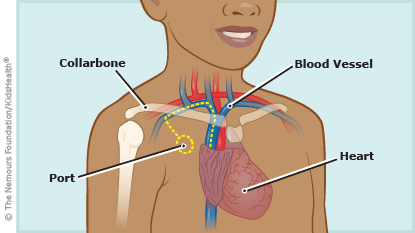- Parents Home
- Para Padres
- A to Z Dictionary
- Allergy Center
- Asthma
- Cancer
- Diabetes
- Diseases & Conditions
- Doctors & Hospitals
- Emotions & Behavior
- First Aid & Safety
- Flu (Influenza)
- Food Allergies
- General Health
- Growth & Development
- Heart Health & Conditions
- Homework Help Center
- Infections
- Newborn Care
- Nutrition & Fitness
- Play & Learn
- Pregnancy Center
- Preventing Premature Birth
- Q&A
- School & Family Life
- Sports Medicine
- Teens Home
- Para Adolescentes
- Asthma
- Be Your Best Self
- Body & Skin Care
- Cancer
- Diabetes
- Diseases & Conditions
- Drugs & Alcohol
- Flu (Influenza)
- Homework Help
- Infections
- Managing Your Weight
- Medical Care 101
- Mental Health
- Nutrition & Fitness
- Q&A
- Safety & First Aid
- School, Jobs, & Friends
- Sexual Health
- Sports Medicine
- Stress & Coping
Implanted Ports
What Are Implanted Ports?
An implanted port is a type of central line. A central line (also called a central venous catheter) is like an intravenous (IV) line. But it is much longer than a regular IV and goes all the way up to a vein near the heart or just inside the heart.
A patient can get medicine, fluids, blood, or nutrition through a central line. It also can be used to draw blood.
How Does an Implanted Port Work?
An implanted port starts under the skin on the chest (you can see and feel its raised center). The port connects to a catheter (thin, hollow tube) that is threaded into a large vein near or just inside the heart. The port and the catheter are all under the skin.

Health care providers put a needle into the port to give treatments or draw blood. This is easier and less painful than a typical needle stick. Using a numbing cream or spray on the skin can ease discomfort.
Types of ports include port-a-caths and medi-ports.
When Are Implantable Ports Used Instead of Regular IV Lines?
Doctors might use an implanted port (or other central line) instead of a regular IV line because:
- It can stay in place longer (up to a year or even more).
- It makes it easier to draw blood.
- Patients can get large amounts of fluids or medicines (like chemotherapy) that might not go through regular IVs.
Doctors may place an implantable port (or other central line) for someone who:
- has a serious infection so they can get IV antibiotics for a few weeks
- has cancer so they can get chemotherapy and blood tests through the line
- needs IV nutrition
- will need many blood transfusions
How Is an Implanted Port Placed?
Before the port is placed, your child will get medicine to relax and not feel pain.
To place the port, a doctor will:
- Clean and numb the skin where the port will go.
- Make two small cuts in the skin.
- Thread the catheter into a vein in the chest using ultrasound to guide where the line goes.
- Thread the line into a large vein near the heart or just into the heart.
- Check the placement of the line with an X-ray.
- Place a dressing (a type of bandage) over the area.
Are There Risks to an Implanted Port?
There are some risks to all ports, but most don't cause problems. If problems do happen, it is usually because the port gets infected or stops working. Very rarely, a port can cause a blood clot. Doctors review the risks with families before placing the port.
When Should I Call the Doctor?
Call your doctor if your child has:
- redness or swelling where the port is
- new or worse pain where the port is
- fluid or pus coming from the port area
- a fever
How Can Parents Help?
After the skin over the port heals, the area doesn't need special care. Kids can go to school and do most regular activities. They can swim and bathe normally. Check with your health care team about:
- which physical activities are OK for your child (most kids need to avoid rough play and contact sports)
- how often the port needs to be flushed by a nurse (usually about every 4 weeks)
Tell your child's teachers, school nurse, counselor, and physical education teacher about the port. They can make sure your child avoids any activities that may damage it, and help support your child during treatment.

© 1995- The Nemours Foundation. KidsHealth® is a registered trademark of The Nemours Foundation. All rights reserved.
Images sourced by The Nemours Foundation and Getty Images.